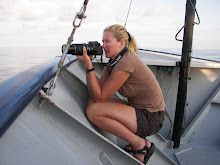Sunday, November 4, 2007
Hello from Station #5 located at 10° 41’41N and 96° 56’6W. The seas calmed down quite a bit for us at our first long station, but are now beginning to pick up again canceling our research plans for tonight. The computers here onboard the ship have been a bit grouchy and so I have focused all my effort on the ETP blog (www.etpcruise.blogspot.com), which details the purpose of this trip and our adventures at sea. Fortunately though it seems that we may have fixed what was wrong, so I can now post some long-awaited pictures onto this site. This research cruise has been an excellent experience for me, exposing me to the technical side of oceanographic research (the methods and equipment involved) and the exciting creatures these tools successfully collect. It has also introduced me to life at sea, which can be very exciting and rewarding (although we all count the days to returning home). On the research vessel, I work for Dr. Karen Wishner from the University of Rhode Island on her MOCNESS team. The MOCNESS (Multiple Opening and Closing Net Environmental Sampling System) consists of a series of 8 nets which can be opened and closed at specific depths in the water column via computer control from onboard the ship. This enables scientists to categorize and enumerate zooplankton populations at specific intervals. In Dr. Wishner’s case, the MOCNESS enables her to identify zooplankton populations at different depths within the oxygen minimum zone, which exists over several hundred meters from beneath the mixed surface layer to approximately 1500 meters in depth. It’s great working with the MOCNESS as I had previously only heard about it through introductory biological oceanography classes.
Subscribe to:
Post Comments (Atom)
.jpg)





No comments:
Post a Comment